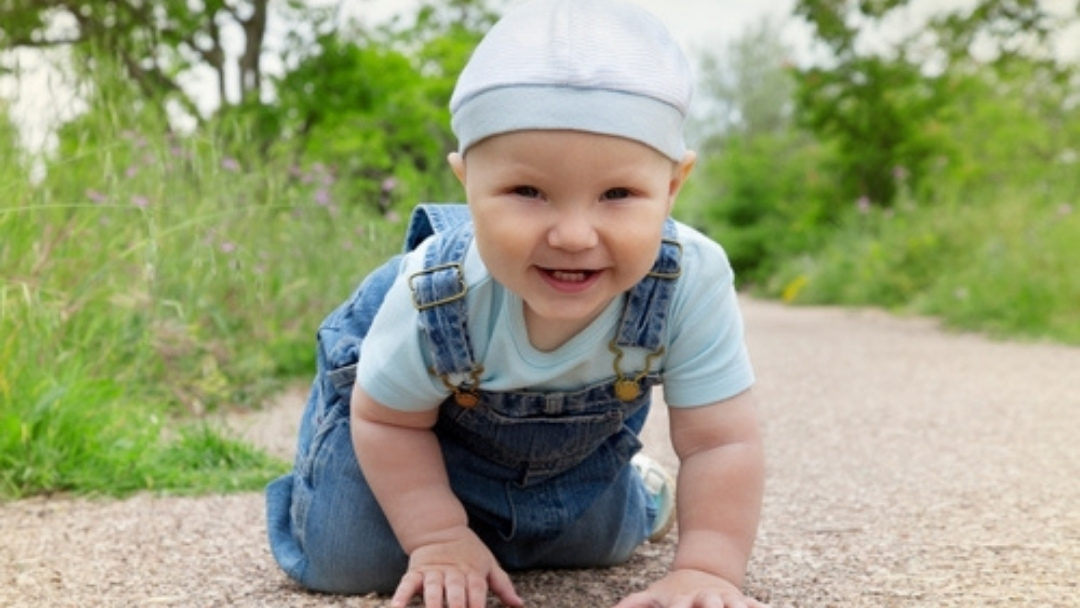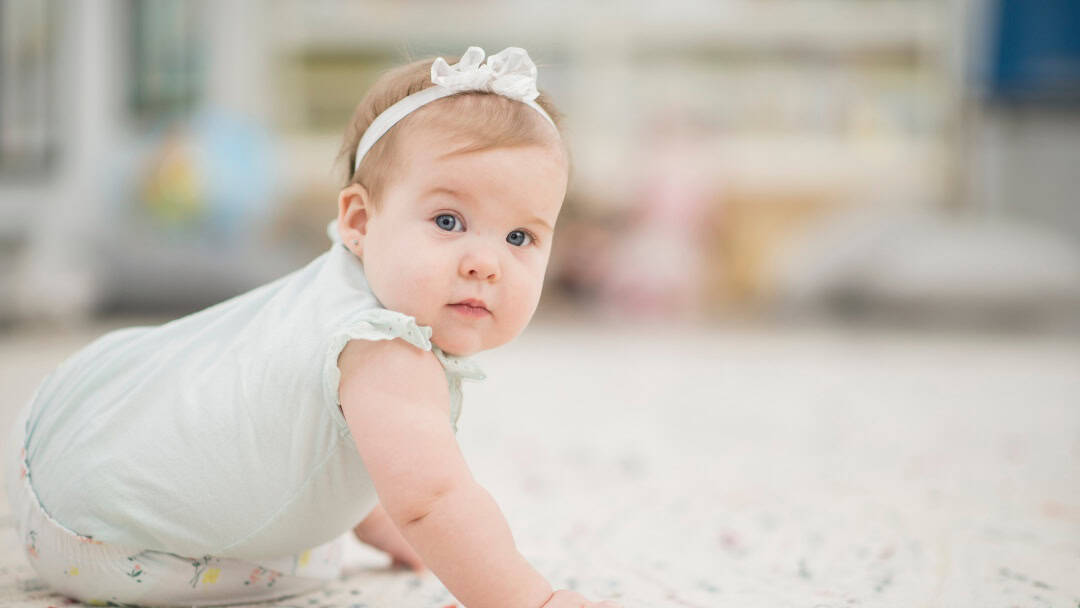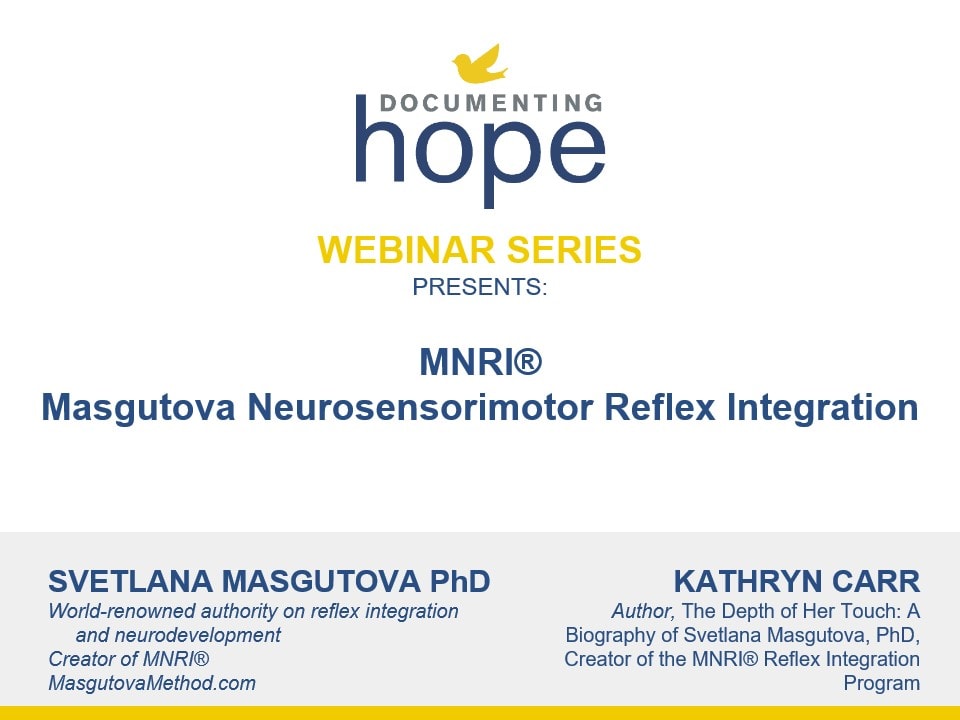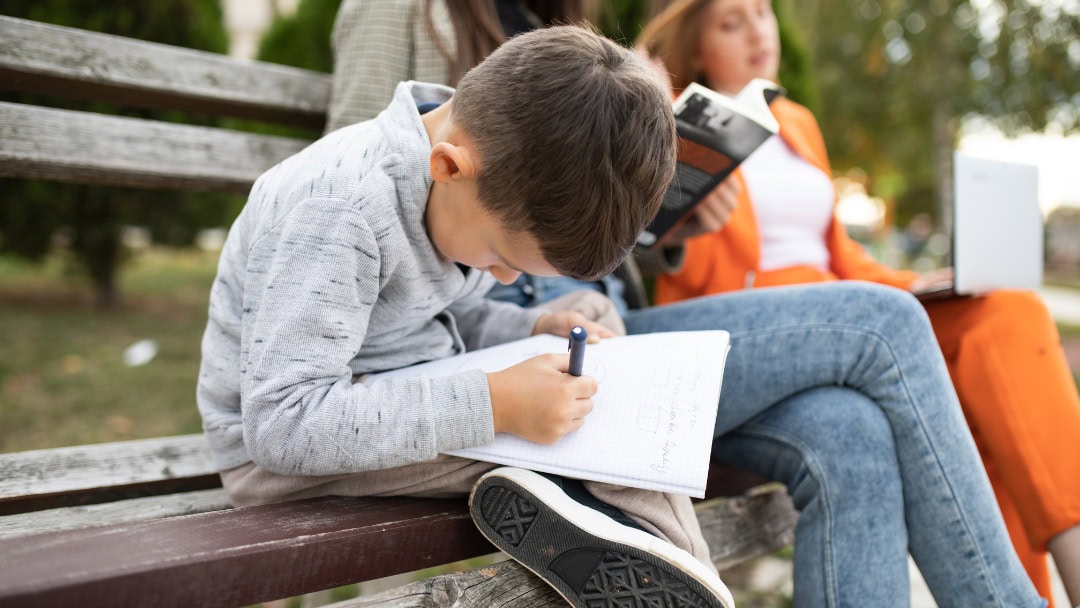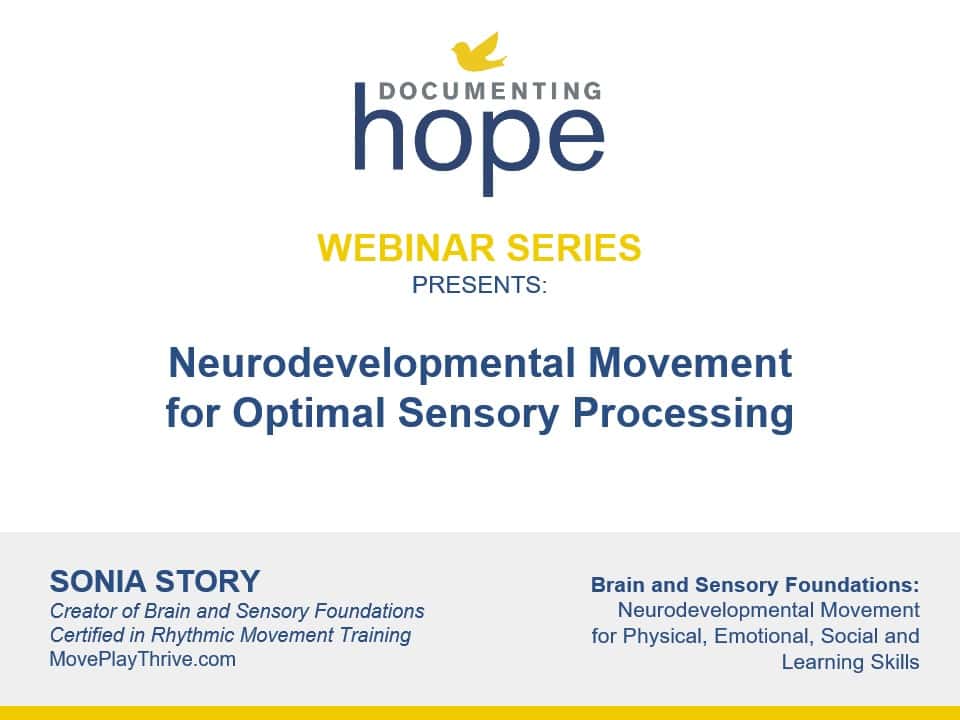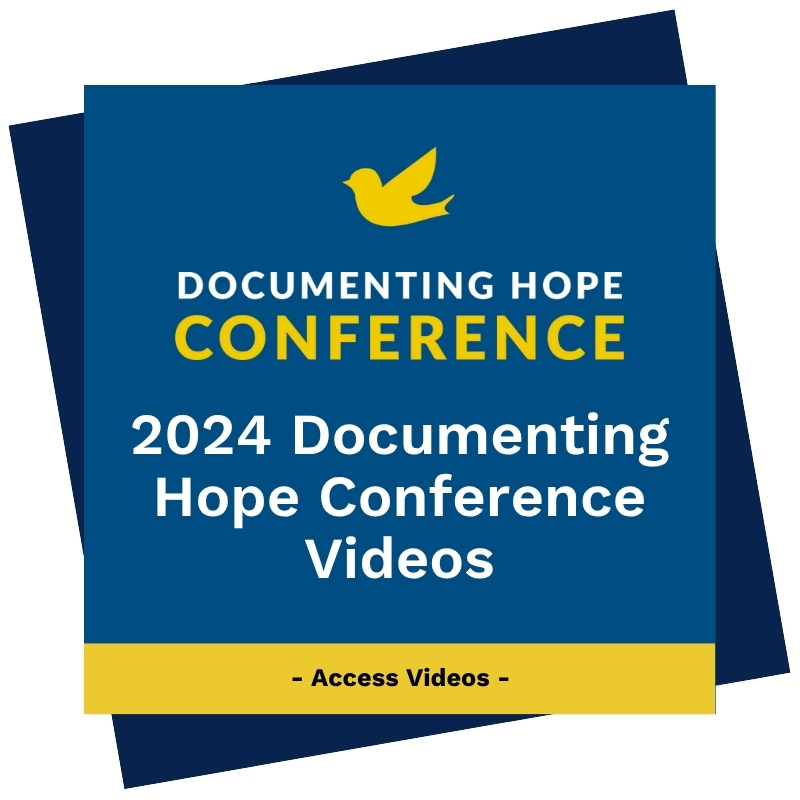Svetlana Masgutova PhD, renowned reflex integration specialist, describes a reflex as an “automatic response of the nervous system as a result of a trigger from a stimulus”, (i.e., touch, movement, etc.) Her life’s work is the Masgutova Method of Neuro-Sensory-Motor and Reflex Integration (MNRI).
In her research, Dr. Masgutova has seen over 3,000 children ranging from one month to 18 years of age and correlated the poor reflex integration patterns to the developmental delays she observed. Consequently, she developed her own sensorimotor and reflex integration program.
Primary Reflexes
All babies have primary reflexes which develop naturally as a means of protection and survival. The more commonly known primary reflexes are:
- Moro
- Rooting
- Palmer
- Asymmetrical Tonic Neck Reflex (ATNR)
- Spinal galant reflex
- Tonic Labyrinthine Reflex (TLR)
- Landau
- Symmetrical Tonic Neck Reflex (STNR)
Each primary reflex has a specific and positive role in the first few years of life but should typically disappear as the child develops. They generally are replaced by postural reflexes which are more mature reflexes needed for balance, coordination and sensorimotor development. Sometimes primary reflexes are retained for a variety of reasons such as:
- Trauma
- Difficult pregnancy
- Difficult birth
- Illness
- Injury
- Emotional trauma
- Chronic stress
All of these insults can lead to learning disabilities, vision problems and developmental delays in areas such as:
- Coordination
- Balance
- Sensory perceptions
- Fine motor skills
- Sleep
- Immunity
- Energy levels
- Impulse control
- Concentration
- Social learning
- Emotional learning
- Intellectual learning
These poorly integrated reflex patterns can be found in children with:
- Cerebral palsy
- Autism spectrum disorders
- Sensory Processing Disorder
- ADD/ADHD
- Dyslexia
- Hyperlexia
- Fetal alcohol syndrome
- Genetic issues
- Brain injury
Dr. Masgutova views the integrated reflex system as a three-part circuit, and each reflex must integrate all three sensory- brain- motor responses. When reflexes don’t integrate well, there is a breakdown somewhere in this three part circuit:
- Sensory organs fail to communicate with the brain
- The brain fails to communicate with the muscles, tendons and ligaments
- The brain-body system confuses the sensory information and the motor response
The Masgutova Method incorporates a variety of gentle body work techniques and simple easy movements to awaken these neuro-sensorimotor connections for proper primary reflex integration. The Masgutova techniques emphasize stimulating neuro-motor and sensorimotor points on the body by:
- Releasing congestion and muscular tension throughout the body
- Stimulating the proprioceptive system
- Opening up communication among the muscles, tendons and ligaments
- Adjusting receptors of deep touch and pressure
- Stretching the trunk and limbs
- Rotating the joints
Other Methods of Reflex Integration
Besides the Masgutova Method, there are other methods of reflex integration such as:
- Rhythmic movement
- Brain and Sensory Foundations
- Brain Balance
Parents should know that most pediatric occupational therapists are not trained in reflex integration and do not use it in their practices. In our opinion, it is best to work on reflex integration before having more traditional sensory integration occupational therapy done for your child. However, it can be difficult to find a therapist who does reflex integration in your area, so you might need to attend a special clinic in another location for your child.
Still Looking for Answers?
Visit the Documenting Hope Practitioner Directory to find a practitioner near you.
Join us inside our online membership community for parents, Healing Together, where you’ll find even more healing resources, expert guidance, and a community to support you every step of your child’s healing journey.
Sources & References
Adolph, K.E., et al. Learning to crawl. Child Dev. 1998 Oct;69(5):1299-312.
Amos, P. Rhythm and timing in autism: learning to dance. Front Integr Neurosci. 2013 Apr 19;7:27.
Akhmatova, N.K., et al. Influence of MNRI on the Immune Status of Children with Down Syndrome. Journal of Clinical & Cellular Immunology. 8 (2017): 1-8.
Barnhill, E. Neural connectivity, music, and movement: a response to Pat Amos. Front Integr Neurosci. 2013 Apr 24;7:29.
Bell, C., et al. The Effect of the MNRI Method on Neurotransmitter Biomarkers of Individuals with Neurodevelopmental Disorders. Neuroscience and Medicine. 2019.
Cho, H., et al. Effects of Action Observation Training with Auditory Stimulation on Static and Dynamic Balance in Chronic Stroke Patients. J Stroke Cerebrovasc Dis. 2020 May;29(5):104775.
Deiss, T., et al. Physiological Markers and Reflex Pattern Progression in Individuals with Neurodevelopmental Deficits Utilizing the MNRI Method. Neuroscience and Medicine. 2019.
Dumuids-Vernet , M.V., et al. Stimulating the motor development of very premature infants: effects of early crawling training on a mini-skateboard. Front Pediatr. 2023 Jun 6:11:1198016.
Gajewska, E., et al. Crawl Position Depends on Specific Earlier Motor Skills. J Clin Med. 2021 Nov 29;10(23):5605.
Goddard Blythe S. Are Immature Neuromotor Skills Significant Factors in Educational Under-achievement and Special Educational Needs? Literature review of the role of Primitive Reflexes as Indicators and Measures of Neuromotor Immaturity. Special School. (2023);LXXXIV(2):111-123.
Grigg. T.M., et al. Primitive Reflex Integration and Reading Achievement in the Classroom. Journal of Neurology and Experimental Neuroscience. 2023; 9(1), 18-26.
Grigg, T.M., et al. Retained primitive reflexes: Perceptions of parents who have used Rhythmic Movement Training with their children. J Child Health Care. 2018 Sep;22(3):406-418.
Grzywniak, C. Integration exercise programme for children with learning difficulties who have preserved vestigial primitive reflexes. Acta Neuropsychologica. 2017;15(3).
Hardy, M.W., et al. Rhythm, movement, and autism: using rhythmic rehabilitation research as a model for autism. Front Integr Neurosci. 2013 Mar 28;7:19.
Herbert, J., et al. Crawling is associated with more flexible memory retrieval by 9-month-old infants. Dev Sci. 2007 Mar;10(2):183-9.
Hong, H.J., et al. Effect of Rhythmic Movement Program to Improve Walking Ability for Elderly Patients with Stroke. Indian Journal of Science and Technology. 2016 Jul;9(26).
Iverson, J.M. Developing language in a developing body: the relationship between motor development and language development. J Child Lang. 2010 Mar;37(2):229-61.
Jordan-Black, J. The effects of the Primary Movement programme on the academic performance of children attending ordinary primary school. Journal of Research in Special Educational Needs. 2005 Nov;5(3):101 – 111.
Kadivar, Z., et al. Effect of step training and rhythmic auditory stimulation on functional performance in Parkinson patients. Neurorehabil Neural Repair. 2011 Sep;25(7):626-35.
Khan, Z., et al. Slow CCL2-dependent translocation of biopersistent particles from muscle to brain. BMC Med. 2013 Apr 4:11:99.
Ladányi, K. et al. Is atypical rhythm a risk factor for developmental speech and language disorders? Wiley Interdiscip Rev Cogn Sci. 2020 Sep;11(5):e1528.
Lakatos, P., et al. A New Unifying Account of the Roles of Neuronal Entrainment. Curr Biol. 2019 Sep 23;29(18):R890-R905.
Masgutova, S., et al. Effect of the MNRI Reflex Neuromodulation on the QEEG and Neurotransmitters of Children Diagnosed with Cerebral Palsy. 2020.
Masgutova, S., et al. Effects of MNRI Visual Reflex Neuro-Training on Visual and Academic Skills of Children with Autism. International Journal of School and Cognitive Psychology 05 (2018): 1-15.
Masgutova, S. Post-Trauma Recovery in Children of Newtown, CT using MNRI Reflex Integration. Journal of
Traumatic Stress Disorders & Treatment. 5(5) 2017.
Masgutova, S., et al. Reflex Profile of Children with Down Syndrome Improvement of Neurosensorimotor Development Using the MNRI® Reflex Integration Program. International Journal of Neurorehabilitation. 3 (2016): 1-9.
Masgutova, S., et al. Progress with Neurosensorimotor Reflex Integration for Children with Autism Spectrum Disorder. 2016.
Masgutova, S. Reflex Integration Disorder as a New Treatment Paradigm for Children with Autism. 2015.
McEwan, M.H., et al. Early infant crawling experience is reflected in later motor skill development. Percept Mot Skills. 1991 Feb;72(1):75-9.
McWhirter, K., et al. The association between learning disorders, motor function, and primitive reflexes in pre-school children: A systematic review. J Child Health Care. 2022 Jul 13;13674935221114187.
Melillo, R., et al. Persistent Childhood Primitive Reflex Reduction Effects on Cognitive, Sensorimotor, and Academic Performance in ADHD. Front Public Health. 2020 Nov 17;8:431835.
Mohamed, M.A., et al. Sensory integration versus Masgutova neuro-sensorimotor reflex integration program on controlling primitive reflexes and gross motor abilities in children with diplegic cerebral palsy. Physiother Res Int. 2023 Jun 29;e2030.
Nowak, K., et al. Evaluation of the Therapeutic Effect of MNRI Reflex Neuromodulation on Children Diagnosed with Autism Based on Reflex Assessments, QEEG Analysis and ATEC Questionnaire. 2020.
Pilecki, W., et al. The impact of rehabilitation carried out using the Masgutova Neurosensorimotor Reflex Integration method in children with cerebral palsy on the results of brain stem auditory potential examinations. Adv Clin Exp Med. 2012 May-Jun;21(3):363-71.
Schmidt, N.B., et al. Exploring human freeze responses to a threat stressor. J Behav Ther Exp Psychiatry. 2008 Sep;39(3):292-304.
Stephens-Sarlós, E., et al. Changes in primitive reflexes in older adults and their relationship to mental health indices: An experimental investigation. Exp Gerontol. 2024 Oct 15:196:112583.
Stephens-Sarlós, E., et al. The efficacy of the sensorimotor training program on sensorimotor development, auditory and visual skills of schoolchildren aged 5–8 years. Child & Youth Care Forum. 2024 Aug;54(2):323-352.
Stephens-Sarlós, E. The relationship between primitive reflex profile and development of vestibular maturity in early school years. Exercise and Quality of Life Journal (2024) 16(2): 11-16.
Suh, J.H., et al. Effect of rhythmic auditory stimulation on gait and balance in hemiplegic stroke patients. NeuroRehabilitation. 2014;34(1):193-9.
Tatarinova, T.V., et al. The Impact of MNRI Therapy on the Levels of Neurotransmitters Associated with Inflammatory Processes. Int J Mol Sci. 2020 Feb 18;21(4):1358.
Teitelbaum, P., et al. Movement analysis in infancy may be useful for early diagnosis of autism. Proc Natl Acad Sci U S A. 1998 Nov 10;95(23):13982-7.
Teitelbaum, P., et al. Reflexes gone astray in autism in infancy. Journal of Developmental and Learning Disorders, 2003;6, 15-22.
Van Hirtum, T., et al. Is atypical rhythm a riskfactor for developmental speech and language disorders? J Assoc Res Otolaryngol. 2021 Jul;22(4):465-480.
Winkler, I., et al. Newborn infants detect the beat in music. Proc Natl Acad Sci U S A. 2009 Feb 17;106(7):2468-71.
Xiong, Q.L., et al. Measurement and Analysis of Human Infant Crawling for Rehabilitation: A Narrative Review. Front Neurol. 2021 Oct 11:12:731374.
Zaigham, M., et al. Prelabour caesarean section and neurodevelopmental outcome at 4 and 12 months of age: an observational study. BMC Pregnancy and Childbirth. 2020 (20)564.
Zentner, M., et al. Rhythmic engagement with music in infancy. Proc Natl Acad Sci U S A. 2010 Mar 30;107(13):5768-73.
Resources
Articles
Gazca, M. Rebooting Development with a Rhythmic Motor Intervention for Children. Minneapolis: St. Catherine University, May 2012.
Move, Play, Thrive: Vision Doctor on Rhythmic Movements + Research about Visual Processing Issues.
Svetlana Masgutova Educational Institute: What can make reflexes dysfunctional.
Books
Blomberg MD, Harald and Dempsey, Moira. Movements That Heal, Rhythmic Movement Training and Primitive Reflex Integration. Independenly published, 2011.
Brandes, Bonnie. The Symphony of Reflexes: Interventions for Human Development, Autism, ADHD, CP, and Other Neurological Disorders. CreateSpace Independent Publishing Platform, 2016.
Carr, Kathryn. The Depth of Her Touch: A Biography of Svetlana Masgutova, PhD, Creator of the MNRI® Reflex Integration Program. Svetlana Masgutova Educational Institute. September 1, 2023.
A Collective Work. Reflexes: Portal to Neurodevelopment and Learning. Svetlana Masgutova Educational Institute, LLC; First Edition. January 1, 2015.
Dennison, Paul E., et al. Brain Gym: Simple Activities for Whole Brain Learning. Edu Kinesthetics. June 1, 1992.
Goddard Blythe, Sally. The Well Balanced Child: Movement and Early Learning. Hawthorn Press, 2005.
Goddard, Sally. Reflexes, Learning and Behavior, A Window Into the Child’s Mind. Fern Ridge Press, 2005.
Masgutova, Denis, et al. Parents' Guide to MNRI® Masgutova Neurosensorimotor Reflex Integration. Svetlana Masgutova Educational Institute, LLC; First Edition. January 1, 2015.
Masgutova, Svetlana, et al. Autism: Maximize Potential with MNRI® Reflex Integration. Svetlana Masgutova Educational Institute; First Edition. January 1, 2023.
Masgutova, Svetlana, et al. MNRI® Reflex Integration for Your Daily Well-Being. Svetlana Masgutova Educational Institute, LLC. January 1, 2020.
Masgutova, Svetlana, et al. Post Trauma Recovery: Gentle, Rapid, and Effective Treatment with Reflex Integration. 1st World Publishing. January 17, 2018.
Masgutova, Svetlana, et al. Trauma Recovery - You Are A Winner; A New Choice Through Natural Developmental Movements. 1st World Publishing. May 24, 2007.
Websites
Balance Brain Achievement Centers
Institute for Neuro-Physiological Psychology
My Child Will Thrive: Primitive Reflexes Cheat Sheet

